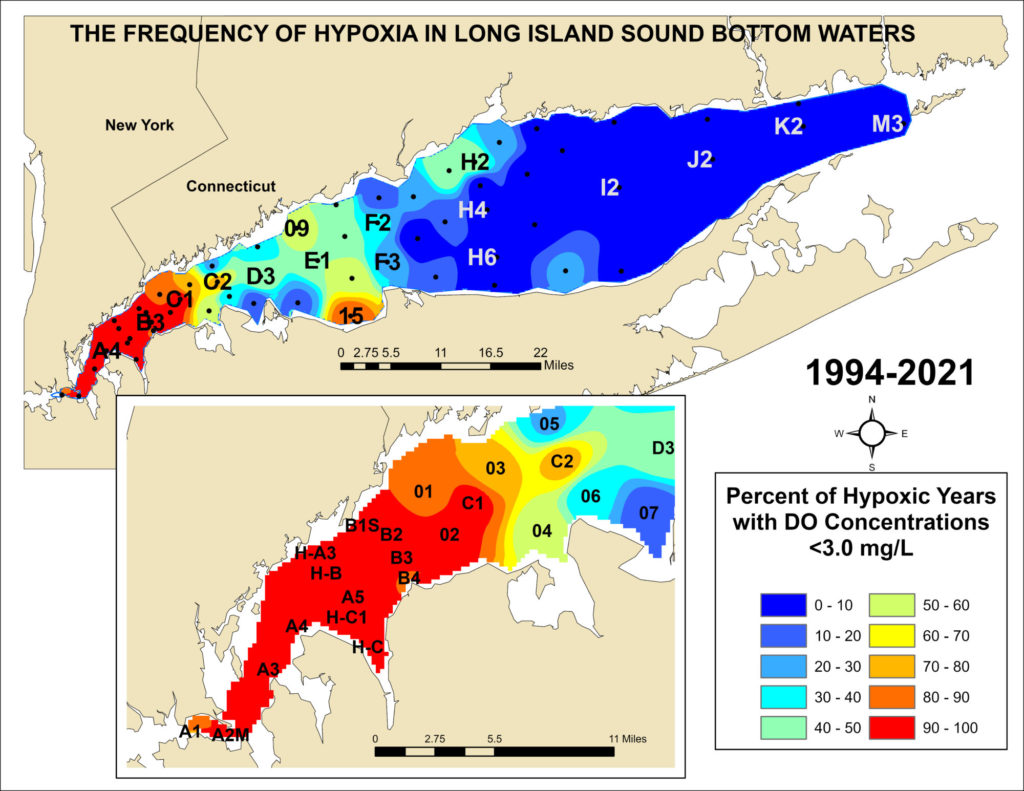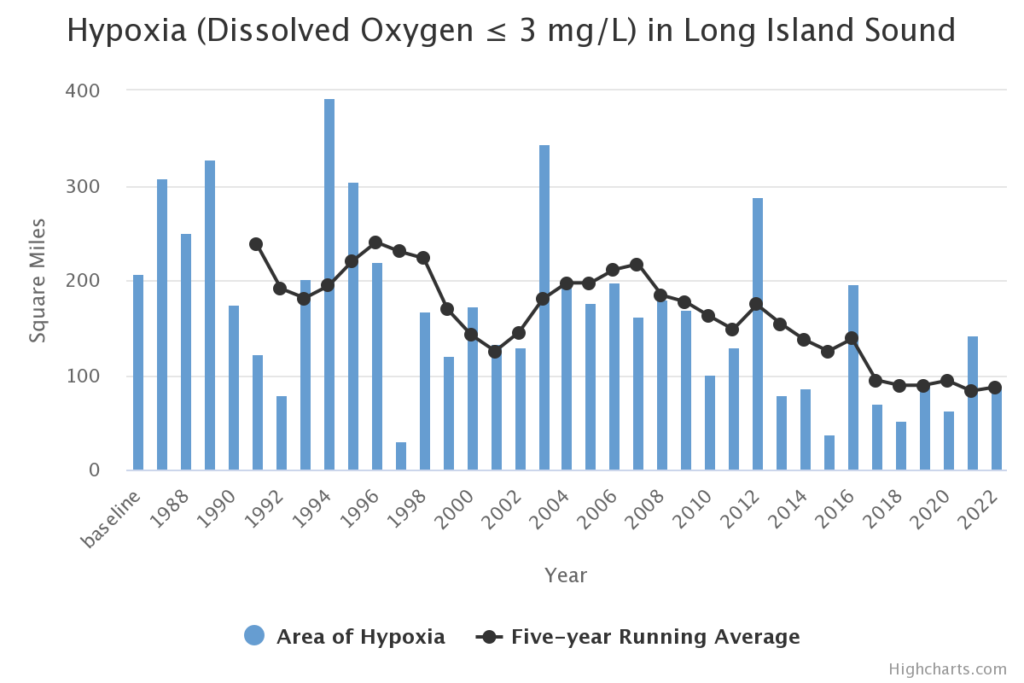Excess nitrogen reduces dissolved oxygen to unhealthy levels, making it a primary threat to water quality in Long Island Sound (LIS).
Impacts of Excessive Nitrogen
When nitrogen levels rise, dissolved oxygen (DO) levels in aquatic ecosystems decrease. Low DO levels, or hypoxia, harm aquatic life and ecosystem health, and contribute to harmful algal blooms.
Primary sources of nitrogen in LIS include:
- Wastewater treatment facilities
- Septic systems
- Stormwater runoff
- Fertilizer runoff
Addressing nitrogen pollution is a core goal of the Long Island Sound Partnership (LIS Partnership, formerly known as the Long Island Sound Study or LISS), a NEIWPCC program partner.

The Plan: Long Island Sound Total Maximum Daily Load
To address the excess nitrogen and resulting DO problems, the Connecticut Department of Energy and Environmental Protection (CT DEEP) and New York State Department of Environmental Conservation (NYS DEC) identified the maximum amount, or Total Maximum Daily Load (TMDL), of nitrogen that can be discharged to Long Island Sound. The plan outlines nitrogen reductions necessary to meet water quality standards in the Sound. The U.S. Environmental Protection Agency (EPA) approved the LIS TMDL in 2001, which mandates a 58.5% reduction in human-generated nitrogen.
Measuring Success
The LIS TMDL reevaluation process has been underway since the adoption of the original TMDL. The plan’s phased implementation schedule includes a reevaluation of the allocations based upon advances in monitoring, modeling, research, implementation, water quality criteria and other factors. This process is supported by LIS Partnership and its partners, including NEIWPCC.
Advances in monitoring, modeling, research, implementation, water quality criteria and other factors make a constant reevaluation of the nitrogen allocations within the LIS TMDL necessary. This reevaluation process has been underway since the adoption of the original TMDL and is supported by LIS Partnership.
The Results
States and partners have monitored LIS for decades in an effort to “restore the urban sea” and sustain the Sound with “waters that are clean, clear, safe to swim in, and charged with life,” as outlined in the 2015 Comprehensive Conservation and Management Plan. The LIS Partnership uses a set of ecosystem targets and supporting indicators to track progress and show results.
Progress has been made in many areas. For example, the area and volume of hypoxia are trending down, showing signs of improvement.

However, other ecosystem targets are behind schedule, such as eelgrass extent. Eelgrass grows in coastal waters, providing habitat and stabilizing sediment, but poor water quality is inhibiting its growth.
Learn more about the ecosystem targets and indicators here.
Continued Progress
Work on the LIS TMDL is ongoing, and further nitrogen reductions remain in progress. Connecticut and New York continue to implement the 2000 TMDL alongside the EPA’s Nitrogen Reduction Strategy, released in 2015. This strategy expands the scope of nitrogen-related impacts to include ecological measurements, such as eelgrass cover.
The NYS DEC launched the Long Island Nitrogen Action Plan (LINAP) in 2015 to reduce the level of nitrogen in surface and ground waters around Long Island Sound. LINAP initiatives – which are supported by NEIWPCC staff – include fertilizer management, water reuse and nutrient bioextraction.
In 2016, CT DEEP developed the Second Generation Nitrogen Strategy. This plan addresses three areas of nitrogen reduction: wastewater treatment plants, nonpoint source/stormwater and embayments.
Related resource: Low-Cost Retrofits for Nitrogen Removal Webinar.
Collaborating for Change
Creating and evaluating the LIS TMDL was a cooperative effort involving staff from NEIWPCC, the states of Connecticut, Massachusetts, New Hampshire, New York, and Vermont, and EPA’s Region 1, Region 2 and LIS offices. Since 2019, NEIWPCC has led the Nitrogen Coordination Work Group, which aims to connect leaders and develop shared goals and a technically sound path toward the various reduction strategies. NEIWPCC, as a regional interstate agency, is well positioned to support these coordination efforts.
Research and Reports
Tracking and Accounting of Nonpoint Source and Stormwater Best Management Practices
This is a multi-phase effort to develop and implement a tracking system for quantitative evaluations of the attainment of stormwater and nonpoint source nitrogen load reductions, as required by the TMDL.
- An Evaluation of Nonpoint Source Pollution Control Measure Tracking Systems for Long Island Sound [Phase I] Final Report
- Long Island Sound Best Management Practices Tracking Tool [Phase 2] Final Report
Nutrient Trading in Long Island Sound
In 2020, NEIWPCC initiated an exploratory study into the opportunities and obstacles to expand water quality trading to further improve water quality and ecosystem health in the LIS watershed.
View the project webpage to learn more.
Low Cost Nitrogen Removal for Wastewater Treatment Plants
This study assessed the feasibility and cost-efficiency of installing low-cost biological nitrogen removal retrofits at select WWTPs in the upper LIS watershed.
- Low Cost Retrofits for Nitrogen Removal at Wastewater Treatment Plants in the Upper Long Island Sound Watershed Final Report
- Appendix A – Approved Quality Assurance Project Plan
- Appendix B – Technical Memorandum
The LIS TMDL Enhanced Implementation Plan Report
This report is a preliminary and qualitative evaluation of the current stormwater and nonpoint source nitrogen control efforts for DO. This analysis is based on nitrogen loading trends, changes in drivers of nitrogen loading, and the scope and effectiveness of on-the-ground nonpoint source and stormwater nitrogen control efforts.
NEIWPCC prepared the Watershed Synthesis Section of the report to evaluate TMDL related implementation efforts at the state and watershed level.
- Connecticut State Section prepared by CT DEEP | Connecticut State Section Appendix A | Connecticut State Section Appendix B
- Massachusetts State Section prepared by MA DEP | Massachusetts State Section Appendices 1-7
- New Hampshire State Section prepared by NH DES
- New York State Section prepared by NYS DEC
- Vermont State Section prepared by VT DEC
For more information, contact Richard Friesner, PhD, coordinator of the Nitrogen Coordination Workgroup, at rfriesner@neiwpcc.org.
